Hud in Poker
In the realm of online poker, where every advantage counts, players are constantly looking for ways to maximize their chances of winning. One such tool that has become indispensable to many, including myself, is the Heads-Up Display, commonly known as the HUD. Throughout my poker play, especially in online tournaments, the HUD has become a crucial ally, offering insights and data that have had a profound impact on my gameplay and strategy.
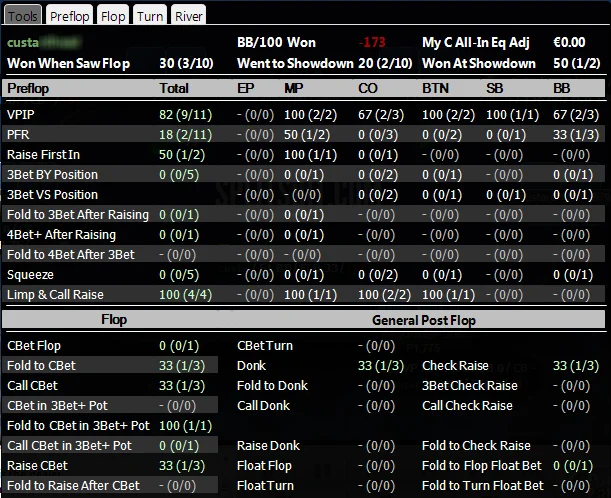
A poker HUD is a software tool that displays statistics and information about your opponents at an online poker table in real time. This data is collected from hands played over countless sessions and provides a complete picture of your opponents’ trends, patterns, and potential weaknesses. For someone like me who has been through the ups and downs of online poker, the introduction of the HUD has not been a revelation or a game changer, but it has helped me discover new ways to analyze players and make decisions in some difficult situations.
The usefulness of the HUD can be overemphasized. It serves as a digital picture of your opponents’ poker personalities, revealing aspects such as their level of aggression, their tendency to fold to raises and their overall style of play. With this information at my fingertips, I was more likely to make more informed decisions, tailoring my strategy to my opponents’ specific vulnerabilities. The HUD became a tool and an extension of my strategic thinking, allowing me to dynamically adjust my game depending on the data I receive.
But why do you need a HUD? The answer lies in the complexity of online poker. Unlike live play, where physical cues and direct observation play an important role, online poker requires a different set of observational skills. In this case, the HUD bridges the gap by offering multiple cues at once that are absent in digital format. It allows players to maintain a level of full awareness and analytical play that would otherwise be unattainable in the changing online poker environment.
Here I want to talk about the HUD, share the knowledge and experience I’ve gained to help others realize its potential or to make them realize that this tool is not for you. It doesn’t matter if you are an experienced player or a newcomer to the table, understanding how to use a HUD can greatly expand your strategic options or give you information that you can’t use properly and as a result your game can become more fuzzy and based on insignificant factors, so before you run out to download software to use a HUD you should weigh the pros and cons and initially learn how to do basic player analysis and only then move on to HUDs and similar metrics.
What is Hud in Poker
A HUD is essentially software that collects and displays statistics about your opponents in real time, right on the poker table interface. This data, collected from hands played over many sessions, provides information about your opponents’ behavior, tendencies, and weaknesses, allowing you to make adjustments on the fly.
In my personal experience, three software solutions epitomize the capabilities and benefits of using HUDs in online poker: PokerTracker 4, Hold’em Manager 2, and DriveHUD. Each of these platforms offers a set of features designed to analyze gameplay, track opponent statistics and improve decision making. PokerTracker 4 and Hold’em Manager 2, in particular, are stalwarts of the poker community, known for their more accurate analysis and user-friendly interfaces. DriveHUD, meanwhile, is becoming an alternative, offering less accurate analytics, but this is by choosing a smaller sample of games to analyze players than other programs, which in turn will reduce the time it takes to get all the game data on an opponent, which is also an important consideration when playing poker.
The effective use of HUD is difficult. The first encounter with such statistical software can be intimidating. The barrage of numbers and indicators can easily overwhelm the uninitiated and lead to misinterpretation and consequent errors. My familiarity with HUD has taught me that mastery of these tools is not innate, but is acquired through study and practice, and not always the study of this indicator gives an increase in profit in your game or improvement of poker skills because this tool is not designed to make an accurate and correct analysis of poker metrics and build their strategies from them.
Before you can fully integrate a HUD into your strategy, you need to take the time to understand the nuances of the software. Each program – whether it’s PokerTracker 4, Hold’em Manager 2, or DriveHUD – has its own features and unique training. Familiarizing yourself with specific features, customizing the display to your needs, and knowing how to accurately interpret data are all crucial steps to utilizing the full potential of the HUD.
How to Properly Use HUD When Playing Poker
Full mastery of the HUD depends not only on understanding the tool itself, but also on understanding several other metrics that underpin its utility. Before diving into the complexities of HUDs, it is important to familiarize yourself with a set of indicators that serve as the basis for informed decision making. These metrics are taken from my own experience and preferences, other poker pros have their own metrics that they adhere to, each one is unique so don’t think you can’t change them or make your own changes:
- VPIP
- PFR
- 3-betting frequency
- WTSD
- W$SD/WSD
- WWSF
- Fold to 3-bet after a raise
- Preflop squeeze
- Cont-bet on the flop
- Fold on the Flop
Each of these metrics provides insight into your opponents’ tendencies and strategies, as well as your own play. For example, VPIP and PFR provide insight into a player’s overall aggressiveness, while metrics such as 3-bet frequency and fold to 3-bet after a raise allow you to examine more subtle aspects of preflop dynamics. Understanding the significance of showdown exit (WTSD) and showdown success percentage (W$SD/WSD) can shed light on the postflop strategy of both yours and your opponents. Similarly, metrics such as WWSF, preflop squeeze, flop counter-bet and flop fold allow you to understand the flow of aggression and defensive play throughout the hand.
VPIP
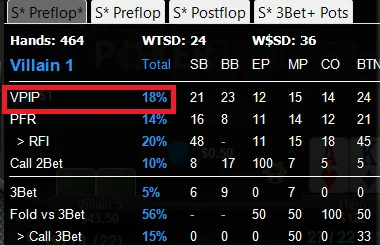
The VPIP value provides an indication of how aggressive or passive a player is preflop. Typically, a player with an understanding of preflop dynamics will exhibit a VPIP in the 20-30% range in a six-handed game. A VPIP around 25% is often seen as consistent with a solid, balanced approach to preflop play. These percentages are very important in assessing how selective a player is going into the pot and can indicate his potential hand range.
However, it is important to note that VPIP only becomes a reliable indicator of a player’s strategy after observing about 300 hands. This sample size provides enough data to accurately assess a player’s preflop tendencies. For example, seeing a player with a VPIP of 70% or even 50% indicates a lack of selectivity in hand selection, which often indicates a novice player. Such high VPIP values indicate that a player enters the pot with a wide range of hands, regardless of their strength.
This insight allows more experienced players to adopt an exploitative strategy to address the novice player’s tendency to overplay hands. By recognizing the high VPIP percentage and adapting to it, experienced players can position themselves correctly to take over the pot of more inexperienced opponents.
PFR
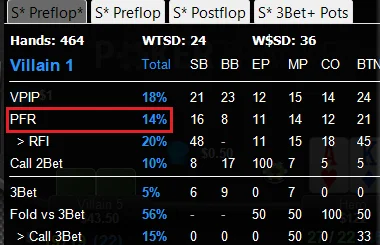
PFR measures the frequency with which a player raises before the flop. This includes any situation where a player takes the initiative to raise, setting the tone for the development of the hand. It is a simple but powerful indicator that sheds light on a player’s pre-flop strategy, showing whether he is inclined to play aggressively, going into the pot with a raise rather than a call or a fold.
According to my observations and analysis, a player with a good understanding of the preflop fundamentals usually shows a PFR in the 15-25% range. A figure in the neighborhood of 19% is often indicative of a well-balanced approach to raising preflop bets. These percentages are more than just numbers, they provide insight into the selectivity and assertiveness of a player’s play, painting a picture of his strategic preferences before the community cards even hit the table.
As with VPIP, the true value of PFR as a tool becomes apparent in a sample size of around 300 hands. This volume of play is usually enough to get a good idea of a player’s preflop tendencies. Encountering a player whose PFR is in the aforementioned range suggests an approach to hand selection and aggression. Conversely, deviations from this range may indicate a more passive or overly aggressive strategy, offering clues as to how to adjust your play to maximize your profits.
WTSD
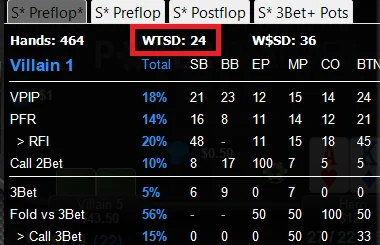
Also, for a better understanding of how the HUD works, it is necessary to understand how the WTSD works because they should be used together to fully understand how poker indicators work and to have a complete picture of how different players play and what their style of play is. WTSD shows how often a player reaches showdown after seeing the flop. This statistic is important for understanding your opponent’s post-flop strategy, including whether they tend to be aggressive or cautious as the hand progresses.
To illustrate, consider a scenario in which a player sees the flop 11 times per session and reaches showdown on 5 of those occasions. In this case, the WTSD percentage for the session would be 40%. This example shows the informative importance of the WTSD statistic, which gives an indication of how often a player is willing to bring his hand to showdown.
The normal WTSD rate is usually in the range of 27-32%, with the optimal percentage hovering around 30%. If you come across a player whose WTSD matches this range, it will usually be a well-trained and experienced poker player. Such a percentage indicates a balanced approach to postflop play, he is not too eager to showdown with weak hands and does not over-fold strong hands prematurely.
However, it is important to emphasize that WTSD, while informative, requires a much larger sample size to serve as a reliable basis for adjustments compared to metrics such as VPIP and PFR. In order to accurately assess your opponent’s tendencies and effectively strategize against him, it is advisable to observe at least 8,000 hands. This sample size ensures that the WTSD statistics provide a complete overview of a player’s post-flop behavior, taking into account the inherent variance in poker.
3-bets
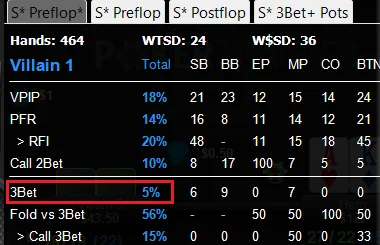
One such important metric, especially relevant to preflop play, is the frequency of 3-bets. This metric shows how often an opponent 3-bets or re-raises preflop. In my experience, knowing the nuances of this metric has helped me develop an effective defense against players who frequently 3-bet, allowing me to adapt my strategy to counter their aggressive preflop actions.
The frequency of 3-bets is a powerful indicator of your opponent’s aggression level and his hand selection criteria pre-flop. As a rule of thumb, a general 3-bet frequency in the range of 6-10% is considered typical for the entire spectrum of players. However, it is the players with a 3-bet frequency of around 8% who often demonstrate an understanding of preflop. Such players show a sensible approach to 3-betting, indicating that when they decide to re-raise, they likely have a strong hand. This level of selectivity in 3-betting has taught me that these players show considerable caution in their preflop encounters, preferring aggression when the strength of their hand justifies it.
Confronting opponents who exhibit a tight 3-betting pattern requires strategic countermeasures. Judging from my poker encounters, one effective tactic against such tight 3-bets is to respond with a 4-bet to their 3-bet. This approach requires an understanding of both your range and your opponent’s range.
Unlike other indicators, this indicator has given me a really important point that has improved my game, so I suggest you take a closer look at it. Realizing the importance of this indicator and reacting appropriately to the aggression it indicates has allowed me to navigate preflop with more confidence. Whether it’s countering a 3-bet with a calculated 4-bet or adjusting opening ranges to mitigate the impact of aggressive 3-bets, knowing and applying 3-bet frequencies has been crucial in improving my overall poker strategy.
WSD
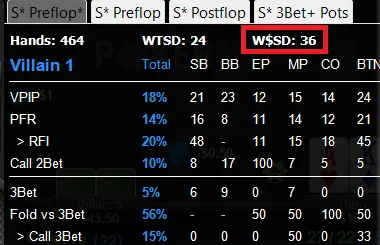
The WSD metric (W$SD for short), important on its own, becomes especially insightful when used in tandem with WTSD, offering a more nuanced view of the post-flop game. In my playing experience, understanding and applying W$SD has been instrumental in fine-tuning my approach and strategy against various opponents.
W$SD determines the frequency with which a player wins money when a hand reaches showdown. Essentially, it is a clear indicator of how successful a player is or in other words it shows the winrate of a particular player. This information is very valuable as it shows the resilience of the opponent at showdown and as a result on the strength and viability of his play in decisive hands.
The statistics associated with W$SD are quite interesting, with strong play the W$SD usually ranges between 49% and 54%. Being in this range indicates that the player is able to reach showdown with competitive hands and use these opportunities to win the pot. Conversely, deviations from this range can indicate different aspects of a player’s strategy. For example, a lower W$SD may indicate a tendency to bluff in the pot or, conversely, an aggressive bluffing strategy on the part of the player, resulting in fewer showdowns, but not necessarily less profitability.
To really use W$SD as a basis for building your strategy, you need to collect data on a significant number of hands. As with WTSD, a sample size of around 8,000 hands is recommended to ensure the reliability of the W$SD figure. This amount of play provides a robust data set, minimizes the impact of variance, and allows you to more accurately adjust your strategy based on the observed W$SD metrics.
In my poker journey, the inclusion of W$SD in my analytical toolkit has been crucial. By closely monitoring this metric, I was able to determine not only the showdown efficiency of my opponents, but also their broader strategic tendencies – whether they tend to fold under pressure or bluff their way to victory. This insight, based on thousands of hands played, allows me to adapt my approach, choosing when to challenge my opponents’ bluffs and when to tighten my own range in anticipation of a showdown.
WWSF
WWSF cannot fully reveal the entire gameplay of an opponent, it certainly gives an indication of his experience level and general approach to postflop play. The WWSF measures the frequency with which a player wins the pot after seeing the flop. As such, this statistic provides insight into a player’s effectiveness in the later stages of a hand, reflecting their ability to capitalize on post-flop situations.
A good WWSF rate ranges between 45% and 53%, with the ideal average hovering around 48%. These percentages serve as a benchmark indicating a player’s skill in post-flop play. Being in this range indicates a balanced strategy that combines the right mix of aggression, bluffing and folding to optimize postflop winnings.
However, deviations from this range can be quite telling. On the one hand, a significantly lower WWSF percentage may indicate a player who is over-folding after the flop or attempting to bluff too often, which does not ensure a pot win. This could indicate a more passive or cautious player, potentially opening up opportunities for exploitation. Conversely, an unusually high WWSF may indicate an overly aggressive strategy where the player is trying hard to win the pot, perhaps risking more than necessary.
Fold to 3-bet after a raise
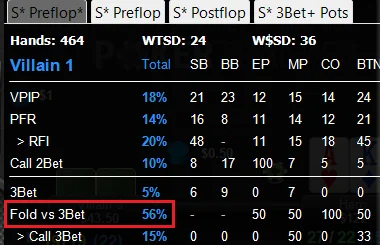
Heads-Up Display (HUDs), the “Fold to 3-bet after a Raise” metric is a really interesting metric. While this statistic is not fundamental, understanding it is critical to a comprehensive analysis of your opponent. This metric becomes useful when broken down into two different scenarios: when a player is out of position (OOP) and when a player is in position (IP). Recognizing the strategic differences in these situations is key to using this metric effectively.
The essence of the “fold to 3-bet after a raiser” statistic lies in its ability to reveal a player and his decision-making process in relation to his positional context. The intricacies of poker strategy become apparent when you consider that a player’s fold rate should naturally vary between OOP and IP. Being in OOP position usually requires a higher fold rate due to the disadvantageous nature of the position, while being in IP position allows for greater equity to be realized, which often justifies a lower fold rate.
In terms of specific percentages, the optimal fold rate is around 40-45% when the player is IP, which implies a narrower range and strategic openness to the opposition. Conversely, when the player is OOP, the fold frequency is slightly higher, around 45-50%, reflecting strategic caution due to positional disadvantage. These percentages emphasize the importance of position in decision making and the strategic adjustments required when faced with a 3-bet after an initiated raise.
A significant sample of hands is necessary for a reliable and valid interpretation of this indicator. In order to draw meaningful conclusions and develop a strategy based on this metric, a minimum of 1,500 hands must be observed. This volume ensures that the data reflects consistent patterns in player behavior, providing a solid basis for strategic adjustments.
Preflop Squeeze
The concept of preflop squeeze is a poker strategy metric that provides significant insight into a player’s aggressiveness and tells you how to effectively counter his three-betting. Understanding and utilizing this metric can make a significant difference in how you approach confronting aggressive opponents.
Preflop squeeze essentially measures the frequency with which a player decides to re-raise after an initial raise from one player and at least one call from another. This action, performed in a situation where the potential pot may grow due to multiple interested parties, is a powerful move indicative of strength or, in some cases, a strategic bluff. Knowing how to identify and react to a squeeze play plays a key role in navigating the complexities of aggressive poker dynamics.
As for the statistical rates of squeeze play on preflop, they are usually in the range of about 7-9%. A rate that is at a higher level often indicates that a player may be taking a weaker approach to squeeze, potentially using this tactic as a bluffing tool. This observation suggests that when faced with a squeeze from such a player, it may make sense to consider a 4-bet, as he may be more inclined to fold to further aggression.
However, in order to draw reliable conclusions based on a player’s squeeze frequency, a significant sample size is needed. In my experience, about 3000 hands with a particular opponent is a reliable basis for accurately assessing his tendency to squeeze. This volume ensures that the observed squeeze rate is not simply a result of variance, but a true reflection of the player’s strategic inclinations.
Counter-Bet on the Flop
Understanding the concept of the continuation bet, or cont-bet, on the flop is crucial for players mastering poker. Essentially, this statistic shows how often a player follows his preflop raise with another bet on the flop, regardless of whether his hand has improved. This action is an equally important aspect of postflop play, serving to test the strength of opponents’ hands and maintain the aggressive momentum established preflop.
For those new to the game, let’s explain that you raised before the flop, and then when you see the flop, you decide to bet again. Such a move is called a counter bet. It is a tactic used to assert dominance in a hand, potentially forcing your opponents out of the pot regardless of the cards that appear on the board. However, the use and effectiveness of the counter-bet depends greatly on the context, whether it’s a 3-bet pot or a single-raiser pot, and whether you’re betting in position (IP) or out of position (OOP).
A subtle approach to cont-betting takes all of these variables into account. In general, it is recommended that you bet more often in position (IP) and in 3-bet pots, between 50-70%. This strategy allows you to take advantage of the position advantage and strength signaled by the 3-bet on preflop. In contrast, if you are out of position (OOP) in single-raiser pots, a more cautious approach should often be taken and the recommended range of cont-bets is 0-30%. These guidelines help balance aggressive intentions and the need for caution depending on the hand dynamics.
Fold to Contbet on the Flop
The “Fold to Contbet on the Flop” statistic provides insight into how players react to post-flop continuation bets following a preflop call. This metric helps you understand whether your opponent is stable postflop or tends to be cautious. As with the analysis of continuation bets, the interpretation of this metric also benefits from variation in different scenarios, whether a one-bet raise or 3-bet followed, and whether the player was in position (IP) or out of position (OOP) during play.
This metric reflects the frequency with which a player, having called a raise preflop, decides to fold when faced with a continuation bet on the flop. This fold reaction is a critical aspect of their defensive play, showing their threshold for maintaining position in the hand when aggression continues on the postflop.
Given the variability due to the size of the bets, it is difficult to determine the ideal frequency of fouls. Nevertheless, my observation is that one should aim for a reasonably low fold rate on a cont-bet, ideally less than 50%. Such a goal encourages a balanced approach, ensuring that the player does not capitulate too easily to aggression, thereby remaining competitive in a wider range of hands.
How Indicators Should be Analyzed
Playing poker and using a HUD requires a deeper understanding of the game and in order to successfully play this strategy you need to be able to use other indicators that tell you important things about poker. Among them are WTSD (Went to Showdown), WSD (Won Money at Showdown) and WWSF (Won When Saw Flop) – the most important indicators, which when analyzed together give a complete picture of the player’s approach to the game. WTSD shows how often a player reaches the showdown, WSD shows the percentage of showdowns won, and WWSF shows the proportion of times a player wins the pot after seeing the flop.
Let’s look at the profiles of two hypothetical players, each exhibiting different behaviors reflected in their WTSD, WSD, and WWSF scores:
Player X: WTSD: 28 / WSD: 55 / WWSF: 50
Player X demonstrates a calculated approach to poker, and a balanced WTSD indicates a selective approach to showdowns. This player’s above-average WSD speaks to his ability to reach the showdown with hands that have a good chance of winning. Combined with a WWSF of 50%, it is clear that Player X is taking an assertive postflop stance, effectively capitalizing on play opportunities. Against such an opponent, who demonstrates strength in both reaching and winning showdowns, a strategy that emphasizes careful hand selection and cautious bluffing would be wise.
Player Y: WTSD: 20 / WSD: 60 / WWSF: 40
Player Y presents a profile of restraint and efficiency. The WTSD at 20 suggests a strategy of avoiding showdowns unless he is confident in the strength of the hand, as evidenced by the impressive WSD at 60%. This player wins a significant majority of the showdowns he enters, although a WWSF of 40% hints at a more conservative pre-flop approach and potential vulnerability to aggressive play. To capitalize on Player Y’s caution, you can put pressure on him in the early betting rounds by encouraging folds before showdowns become a reality.
When analyzing such profiles, it becomes apparent that understanding the relationship between WTSD, WSD and WWSF can reveal the essence of a player’s strategy, allowing for individual approaches to maximize his advantage.
Conclusion
To summarize about HUD and other metrics I wrote about above I can say the following. Considering how much time I spent on testing all these strategies, I came to the following conclusion. If you are a beginner who just came to poker and his winrate is up to 10bb per 100 hands (and I wrote about it in another article) there is no point in using special software like HUD because initially you need to master basic poker skills and tactics anyway. And for more experienced players I want to say that you can use HUD to try to look at the game from a different perspective, but to build a tactic of the game based on these indicators is not worth it because they can not always fully accurately determine what tactics of the game adheres to the opponent. And if you want to use HUD for poker, you should definitely use it in conjunction with other indicators that I wrote about earlier, so use this software competently and do not neglect the basics of poker!

